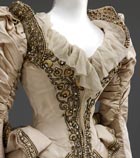Exhibition review: Wedding dresses: 1775–2014
We review the latest exhibition from the V&A which looks at wedding dresses from the 18th century until the present day


When, two years ago, socialite model Lady Mary Charteris, daughter of the Earl of Wemyss and March, married The Big Pink frontman Robbie Furze, accompanied by her dog Alfie and a page in knickerbockered velvet, she wore a white gown with a see-through panelled bodice and fluffy tulle skirt designed by Lady Gaga's favourite designer, Pam Hogg. Although the dress was unconventional, it was still a ‘white wedding' and the fact that this is synonomous with a church, bouquets, bridesmaids and ceremony shows how ingrained the notion is.
Lady Mary's is not the most revealing celebrity dress of recent years. Twenty years earlier, model Lisa Butcher married pin-up chef Marco Pierre White at the Brompton Oratory in a white Bruce Oldfield gown with cut-away, 1960-style sides that showed her slender body. The groom said the dress was ‘not for me' and the marriage lasted 15 weeks. When Gwen Stefani married in 2002, she wore a John Galliano dress that seemed fairly conventional, apart from its pink spray-painted hem, until you saw the back, where it seemed to have been pulled open to show part of a corset.
The truth is that wedding dresses have always been used for effect. In 1933, when Margaret Whigham married Charles Sweeny, the seeds of notoriety-she later, as Duchess of Argyll, became infamous for the ‘headless man' scandal-may already have been sown by her marked liking for attention. Her flamboyant wedding dress by a young Norman Hartnell, with dramatic ‘medieval' sleeves and 18ft train, cutout orange flowers and false-pearl embroidery, took 30 people six weeks to make. With nine attendants, a handsome husband, smouldering green eyes and publicity from Society columnists Don, Valentine and William Hickey, the bride caused jostling onlookers to stop traffic.
These are just some of the more contentious dresses in a must-see exhibition at the V&A, which tells the story of the mainly white, but occasionally coloured or sprigged, British wedding dress, from the 18th century to the present day. Many items on show, including lovely shoes, veils, hats and even garters, are from the museum's own collect-ion, but there are also loans and new acquisitions.
In the 18th century, fashions for ‘bridal attire', as Mrs Delany called it, followed daywear and, for the rich, Court dress. White and silver were the most desirable and costly-and most impossible for the poor. Among beautiful 18th-century examples on show are a 1775 white-silk Court dress, with padded puffs, that the bride would then have been presented in and a sprigged silk with bergère hat and adorable shoes.
Queen Victoria was the first royal bride to break with stiff tradition, marrying in a deliberately simple dress that emphasised her youth (she was 20) and supported British industry. Her dress, currently at Kensington Palace, was made of Spitalfields silk and Honiton lace and had a white train, rather than the conventional crimson-velvet robe of state. Our present Queen's Hartnell wedding gown is not in the exhibition either, nor is Princess Diana's gigantic silk meringue with 25ft train that encapsulated the 1980s, but Lady Sarah Armstrong-Jones's Jasper Conran dress has been kindly loaned, as has the serene dove-grey silk long dress and coat worn by The Duchess of Cornwall, for the blessing following her marriage to The Prince of Wales.

Fashions-with always popular historically inspired exceptions continued to parallel contemporary day dress until 1934. Then, as curator Edwina Ehrman explains, marriage hours were extended to 6pm and dresses began mirroring evening gowns. By the 1990s, backless or strapless dresses were common, as old notions of modesty linked to the qualities of white were less observed, encouraging more individuality.
Exquisite houses, the beauty of Nature, and how to get the most from your life, straight to your inbox.
Yet, as this thrilling exhibition shows, most women long for a white wedding. What particularly delights is the inventive lengths designers have gone to, century after century, to create dazzlingly different dresses to set those wearers off.
‘Wedding Dresses: 1775-2014' is at the V&A, London SW7, until March 15, 2015 (020-7420 9736; www.vam.ac.uk). A new edition of ‘The Wedding Dress; 300 Years of Bridal Fashions' by Edwina Ehrman is published to coincide with the exhibition (V&A Publishing, £30)
* Follow Country Life on Twitter
Country Life is unlike any other magazine: the only glossy weekly on the newsstand and the only magazine that has been guest-edited by His Majesty The King not once, but twice. It is a celebration of modern rural life and all its diverse joys and pleasures — that was first published in Queen Victoria's Diamond Jubilee year. Our eclectic mixture of witty and informative content — from the most up-to-date property news and commentary and a coveted glimpse inside some of the UK's best houses and gardens, to gardening, the arts and interior design, written by experts in their field — still cannot be found in print or online, anywhere else.
